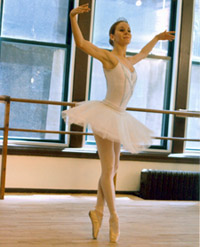The curriculum of Boitsov Classical Ballet School is based strictly on Vaganova Technique, the unique style of Russian ballet used in the Moscow Bolshoi Theatre and the Kirov Ballet. It is one of the highest standards by which a professional dancer can be trained.
Agrippina Vaganova (1879-1951) was not only a great dancer herself, but also the teacher of such ballet legends as Galina Ulanova and Maya Plisetskaya. Her theories of ballet education are expressed in her classic work "Basic Principles of Classical Ballet - Russian Ballet Technique".
Madame Vaganova's goal was to create a unified style that took elements from the Romantic plasticity of the Imperial Russian school, the elegance and refinement of the French school, and the virtuoso dancing of the Italian school. The Vaganova technique produces dancers of both power and dramatic expressiveness. Dancers who come from this training are especially noted for the beauty of their Úpaulement, i.e. the carriage and use of their shoulders, arms, and head.
VariationsVariations are solo dances from the traditional classical ballet repetoire. Both male and female students learn dances from ballets such as "Swan Lake", "Sleeping Beauty", "Don Quixote", "Giselle", and "Raymonda".
Pas De DeuxA dance by a man and a woman together is referred to as a "pas de deux", a dance (or step) for two. For both dancers in a pas de deux, working in close proximity with a partner requires skill, finesse, and communication. Students work in pairs to learn the pas de deux from the traditional classical ballet repertoire.
 Michelina Vrlec (graduate of BCBS Class of 2002) rehearses a "Raymonda" variation in the BCBS studios
Michelina Vrlec (graduate of BCBS Class of 2002) rehearses a "Raymonda" variation in the BCBS studios

